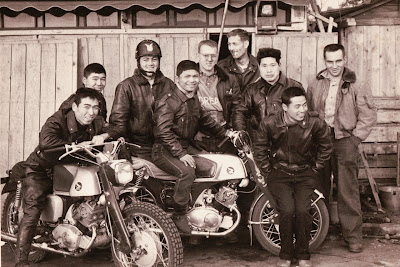Last year, when Marc Marquez pretty much single-handedly resurrected the Superprestigio as a short track race, I pressured him to include Brad Baker, who was then the Grand National Championship #1 plate holder.
When the organizers relented and invited Baker, they at first wanted to create a siamesed event, where World Championship road racers competed in their own race, and outsiders never raced against them. Marquez himself insisted that at the end of the night, the best of the Grand Prix boys would face off against the best short trackers from Europe, along with Baker.
Baker won, to no one’s real surprise, although Marquez kept it close until he crashed (twice.)
In the spirit of complete accuracy, technically there were three Americans in the Superprestigio: Baker, who was sort of an official ambassador for the GNC; Kenny Noyes, who is an American but lives and races in Spain full time; and Merle Scherb who was a part-time GNC competitor and occasional instructor in Colin Edwards’ Texas Tornado motorcycle camp.
Fast forward to this year, and there were three official GNC racers representing the U.S. Baker, again; reigning GNC #1 plate-holder Jared Mees; and Shayna Texter, who rode for Latus Triumph last year.
Again, the structure of competition kept the GNC regulars away from the road racers until the last race. (Though Noyes, as the current CEV Superbike class champion, raced with the Dorna group.)
Trouble came early when Baker crashed hard and dislocated his shoulder in practice. Shayna Texter is not a short track ace; she’s better on the bigger, faster tracks; she didn’t make the final.
That set up the final, U.S. vs. Spain (and the rest of the world) race as a straight, winner take all fight between Mees and Marquez, who’d been untouchable in their respective divisions all day.
Well, maybe it’s a problem. I mean, no really informed observer believes that on balance, Marquez is already better at flat track than the best Americans. But still, that’s how it’s being reported in much of the world.
Motorcycle News in the UK, for example, simply wrote “Marc Marquez has taken on the best of the American flat track world and won, beating three times AMA Grand National champion Jared Mees to win the overall class at the reintroduced Spanish dirt track event.”
Over at MO, editorial director Sean Alexander saw it as setting up a great rivalry for next year, but at least one informed flat track observer on by FB feed was, like, “What the hell? We didn’t win?!?”
The irony in all this is that last year, I had a bizarre Twitter exchange with the Andy Leisner, the boss at Cycle World, who told me that they didn’t want Baker to attend, because they were afraid he’d spank Marquez too bad, and wreck the event. No worries about that any more.
People will equivocate. They were running 17” wheels and GP rain tires; Marquez is used to that setup but Mees was not. Anything can happen in short track. Mees is not the best singles rider in the GNC; and, obviously, Marquez is a very special case. But while a lot of people in the U.S. flat track community are putting a positive spin on the event, I have to think that quite a few of them are also privately shocked.
Last year—and this year until the final race—American flat track craved the global prestige it got from the Superprestigio. But suddenly it seems as if some Spanish johnny-come-lately has just shown up our #1 plate holder.
Next year, AMA Pro Racing should send reinforcements.
NOTE: For the record, before you attack me, personally, for voicing this opinion. Let me make this clear: Jared Mees is a better—much better—flat tracker than Marc Marquez is.
NOTE: For the record, before you attack me, personally, for voicing this opinion. Let me make this clear: Jared Mees is a better—much better—flat tracker than Marc Marquez is.










































